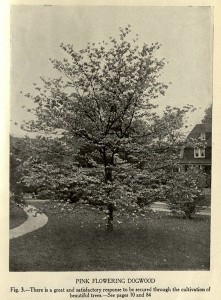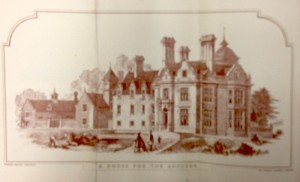Garden design advice with regards to one’s neighbors:
Scott, Frank J. The Art of Beautifying Suburban Home Grounds of Small Extent. Illustrated by upward of two hundred plates and engravings of plans for residences and their grounds, of trees and shrubs, and garden embellishments; with descriptions of the beautiful and hardy trees and shrubs grown in the United States. New York, John B. Alden, 1886, [c1870].
There is no way in which men deprive themselves of what costs them nothing and profits them much, more than dividing their improved grounds from their neighbors, and from the view of passers on the road, by fences and hedges. The beauty obtained by throwing front grounds open together, is of that excellent quality which enriches all who take part in the exchange, and makes no man poorer. As a merely business matter it is simply stupid to shut out, voluntarily, a pleasant lookout through a neighbor’s ornamental grounds. If, on the other hand, such opportunities are improved, and made the most of, no gentleman would hesitate to make return for the privilege by arranging his own ground so as to give the neighbor equally pleasing vistas into or across it. It is unchristian to hedge from the sight of others the beauties of nature which it has been our good fortune to create or secure; and all the walls, high fences, hedge screens and belts of tress and shrubbery…are so many means by which we show how unchristian and unneighborly we can be….To hedge out deformities is well; but to narrow our own or our neighbor’s views of the free graces of Nature by our own volition, is quite another thing. (60-61)
Cridland, Robert B. Practical Landscape Gardening: The Importance of Careful Planning, Locating the House, Arrangement of Walks and Drives, Construction of Walks and Drives, Lawns and Terraces, How to Plant a Property, Laying Out a Flower Garden, Architectural Features of the Garden, Rose Gardens and Hardy Borders, Wild Gardens and Rock Gardens, Planting Plans and Planting Lists. New York, A. T. De La Mare Company, Inc., 1927.
Have some thought for your neighbor and the passerby. Surely such an opportunity is not to be overlooked, for of all the pleasures none is to be compared with that which brings joy to the heart of others.
The owner who plans, builds and cultivates beautiful things is a benefactor, and in no channel of thought or activity is there greater or more satisfying response than in the creation of the beautiful in landscape design (Fig. 3), showing a well placed flowering specimen. (pg. 10)
Eckbo, Garrett. The Art of Home Landscaping. New York: F. W. Dodge Corp., [1956].
Unless some minimum cooperation between neighbors exists- so that each neighbor thinks about what his planning may do to the people next door, and knows that they are just as concerned with what they may do to him- problems like the elm and the roses are bound to arise. (pg. 259)





